International Trade Finance and Pricing Assignment - ECON73020
VerifiedAdded on 2022/11/19
|6
|798
|234
Homework Assignment
AI Summary
This assignment delves into the economics of international trade, addressing key concepts such as the four pillars of trade finance: payment, risk mitigation, financing, and information. It explores the process of documentary collection, outlining the roles of involved parties and essential characteristics. Furthermore, the assignment examines various pricing strategies available to exporters seeking to enter and develop new markets, including static pricing, flexible pricing, penetration pricing, market skimming, and market maintenance pricing. The provided solution offers detailed explanations and references to support the analysis of trade finance and pricing strategies.
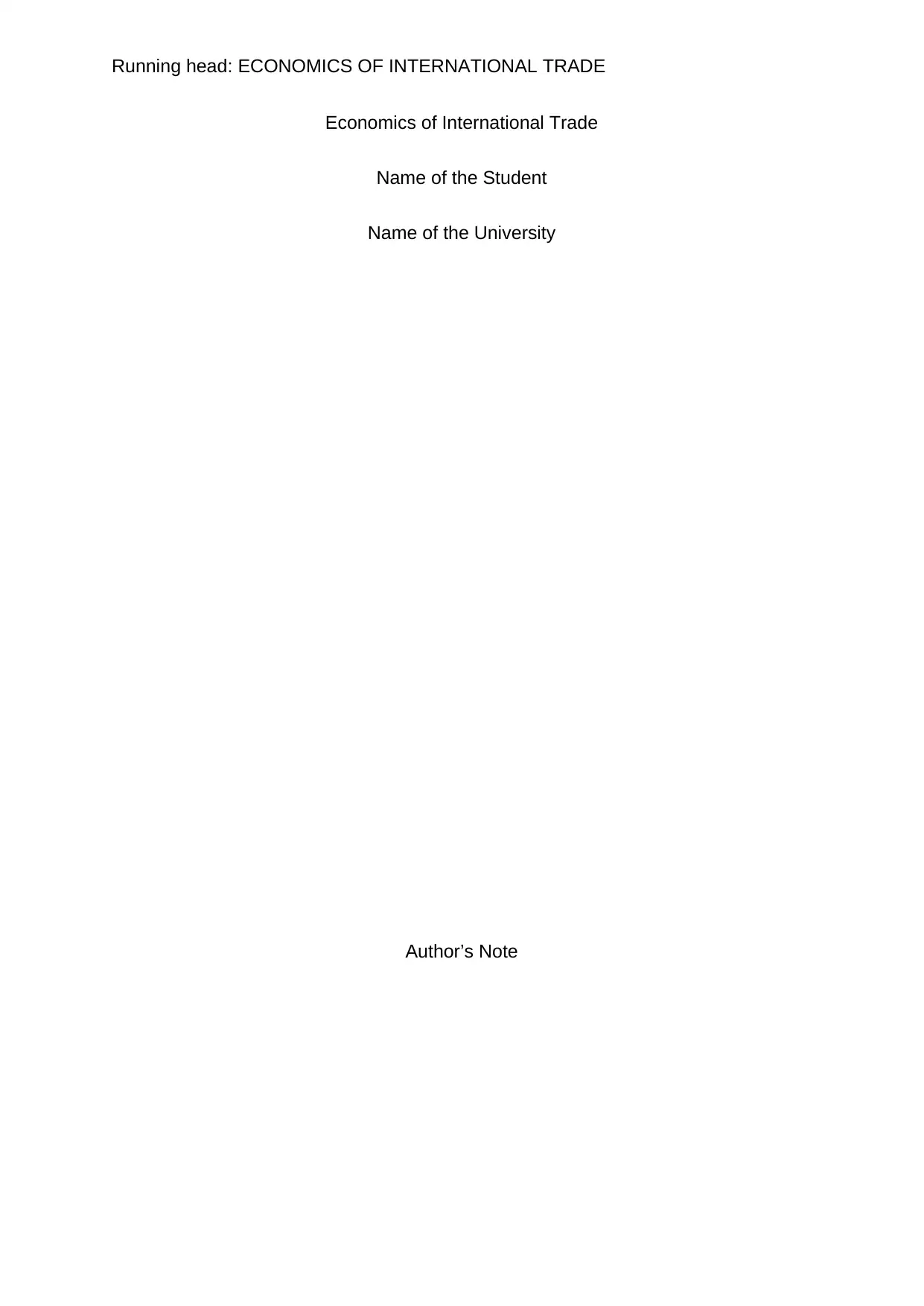
Running head: ECONOMICS OF INTERNATIONAL TRADE
Economics of International Trade
Name of the Student
Name of the University
Author’s Note
Economics of International Trade
Name of the Student
Name of the University
Author’s Note
Paraphrase This Document
Need a fresh take? Get an instant paraphrase of this document with our AI Paraphraser
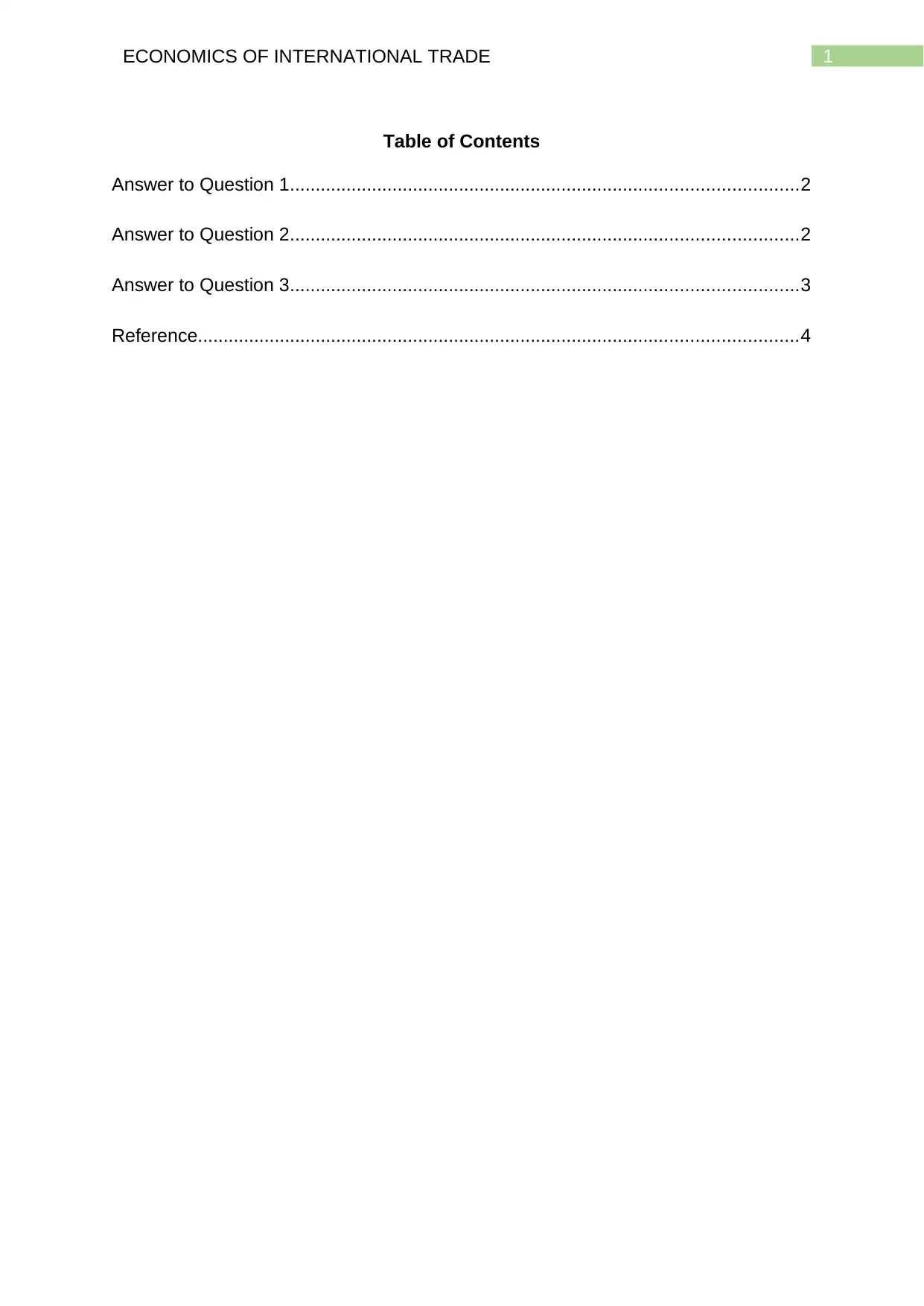
1ECONOMICS OF INTERNATIONAL TRADE
Table of Contents
Answer to Question 1...................................................................................................2
Answer to Question 2...................................................................................................2
Answer to Question 3...................................................................................................3
Reference.....................................................................................................................4
Table of Contents
Answer to Question 1...................................................................................................2
Answer to Question 2...................................................................................................2
Answer to Question 3...................................................................................................3
Reference.....................................................................................................................4
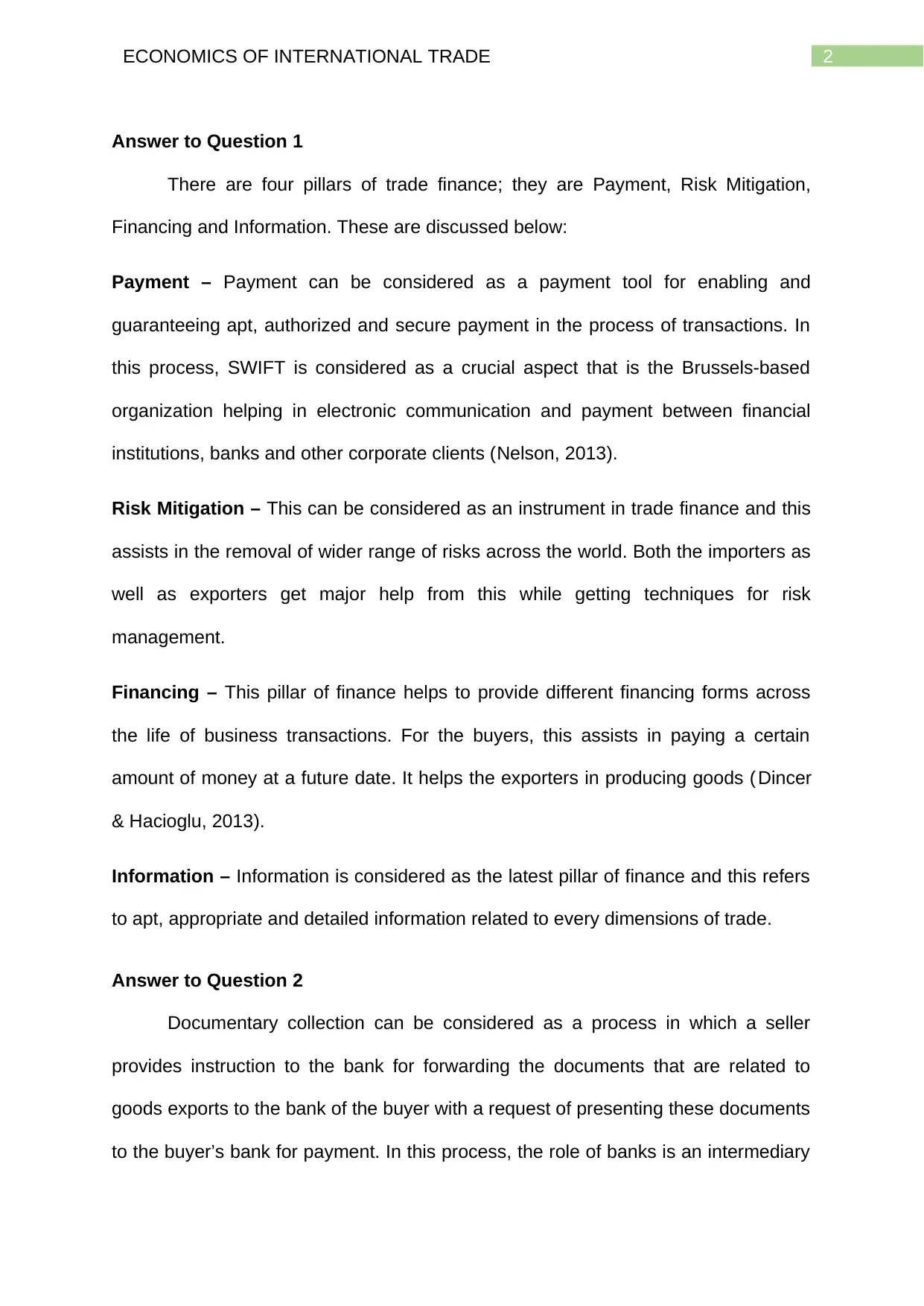
2ECONOMICS OF INTERNATIONAL TRADE
Answer to Question 1
There are four pillars of trade finance; they are Payment, Risk Mitigation,
Financing and Information. These are discussed below:
Payment – Payment can be considered as a payment tool for enabling and
guaranteeing apt, authorized and secure payment in the process of transactions. In
this process, SWIFT is considered as a crucial aspect that is the Brussels-based
organization helping in electronic communication and payment between financial
institutions, banks and other corporate clients (Nelson, 2013).
Risk Mitigation – This can be considered as an instrument in trade finance and this
assists in the removal of wider range of risks across the world. Both the importers as
well as exporters get major help from this while getting techniques for risk
management.
Financing – This pillar of finance helps to provide different financing forms across
the life of business transactions. For the buyers, this assists in paying a certain
amount of money at a future date. It helps the exporters in producing goods ( Dincer
& Hacioglu, 2013).
Information – Information is considered as the latest pillar of finance and this refers
to apt, appropriate and detailed information related to every dimensions of trade.
Answer to Question 2
Documentary collection can be considered as a process in which a seller
provides instruction to the bank for forwarding the documents that are related to
goods exports to the bank of the buyer with a request of presenting these documents
to the buyer’s bank for payment. In this process, the role of banks is an intermediary
Answer to Question 1
There are four pillars of trade finance; they are Payment, Risk Mitigation,
Financing and Information. These are discussed below:
Payment – Payment can be considered as a payment tool for enabling and
guaranteeing apt, authorized and secure payment in the process of transactions. In
this process, SWIFT is considered as a crucial aspect that is the Brussels-based
organization helping in electronic communication and payment between financial
institutions, banks and other corporate clients (Nelson, 2013).
Risk Mitigation – This can be considered as an instrument in trade finance and this
assists in the removal of wider range of risks across the world. Both the importers as
well as exporters get major help from this while getting techniques for risk
management.
Financing – This pillar of finance helps to provide different financing forms across
the life of business transactions. For the buyers, this assists in paying a certain
amount of money at a future date. It helps the exporters in producing goods ( Dincer
& Hacioglu, 2013).
Information – Information is considered as the latest pillar of finance and this refers
to apt, appropriate and detailed information related to every dimensions of trade.
Answer to Question 2
Documentary collection can be considered as a process in which a seller
provides instruction to the bank for forwarding the documents that are related to
goods exports to the bank of the buyer with a request of presenting these documents
to the buyer’s bank for payment. In this process, the role of banks is an intermediary
⊘ This is a preview!⊘
Do you want full access?
Subscribe today to unlock all pages.

Trusted by 1+ million students worldwide
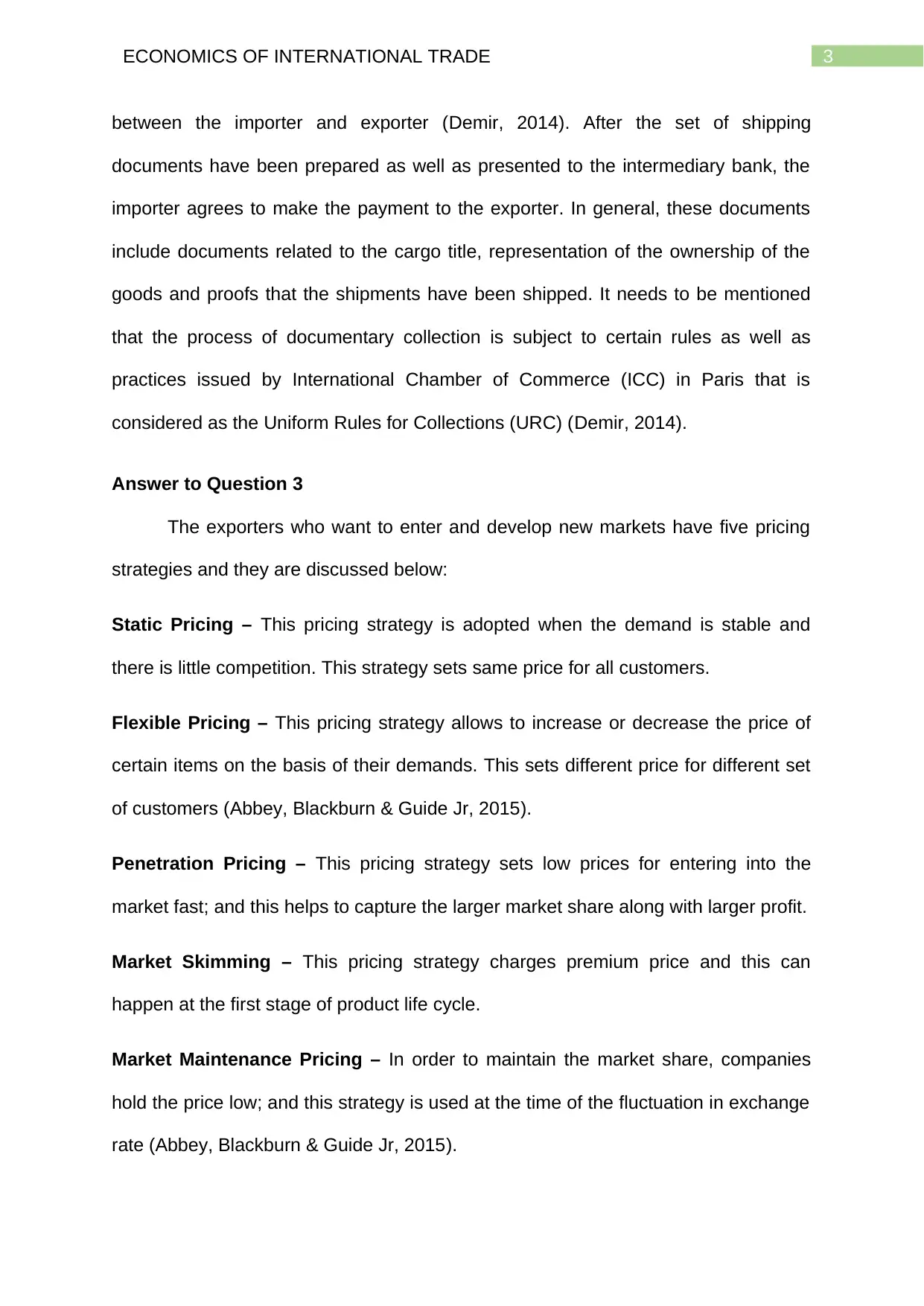
3ECONOMICS OF INTERNATIONAL TRADE
between the importer and exporter (Demir, 2014). After the set of shipping
documents have been prepared as well as presented to the intermediary bank, the
importer agrees to make the payment to the exporter. In general, these documents
include documents related to the cargo title, representation of the ownership of the
goods and proofs that the shipments have been shipped. It needs to be mentioned
that the process of documentary collection is subject to certain rules as well as
practices issued by International Chamber of Commerce (ICC) in Paris that is
considered as the Uniform Rules for Collections (URC) (Demir, 2014).
Answer to Question 3
The exporters who want to enter and develop new markets have five pricing
strategies and they are discussed below:
Static Pricing – This pricing strategy is adopted when the demand is stable and
there is little competition. This strategy sets same price for all customers.
Flexible Pricing – This pricing strategy allows to increase or decrease the price of
certain items on the basis of their demands. This sets different price for different set
of customers (Abbey, Blackburn & Guide Jr, 2015).
Penetration Pricing – This pricing strategy sets low prices for entering into the
market fast; and this helps to capture the larger market share along with larger profit.
Market Skimming – This pricing strategy charges premium price and this can
happen at the first stage of product life cycle.
Market Maintenance Pricing – In order to maintain the market share, companies
hold the price low; and this strategy is used at the time of the fluctuation in exchange
rate (Abbey, Blackburn & Guide Jr, 2015).
between the importer and exporter (Demir, 2014). After the set of shipping
documents have been prepared as well as presented to the intermediary bank, the
importer agrees to make the payment to the exporter. In general, these documents
include documents related to the cargo title, representation of the ownership of the
goods and proofs that the shipments have been shipped. It needs to be mentioned
that the process of documentary collection is subject to certain rules as well as
practices issued by International Chamber of Commerce (ICC) in Paris that is
considered as the Uniform Rules for Collections (URC) (Demir, 2014).
Answer to Question 3
The exporters who want to enter and develop new markets have five pricing
strategies and they are discussed below:
Static Pricing – This pricing strategy is adopted when the demand is stable and
there is little competition. This strategy sets same price for all customers.
Flexible Pricing – This pricing strategy allows to increase or decrease the price of
certain items on the basis of their demands. This sets different price for different set
of customers (Abbey, Blackburn & Guide Jr, 2015).
Penetration Pricing – This pricing strategy sets low prices for entering into the
market fast; and this helps to capture the larger market share along with larger profit.
Market Skimming – This pricing strategy charges premium price and this can
happen at the first stage of product life cycle.
Market Maintenance Pricing – In order to maintain the market share, companies
hold the price low; and this strategy is used at the time of the fluctuation in exchange
rate (Abbey, Blackburn & Guide Jr, 2015).
Paraphrase This Document
Need a fresh take? Get an instant paraphrase of this document with our AI Paraphraser
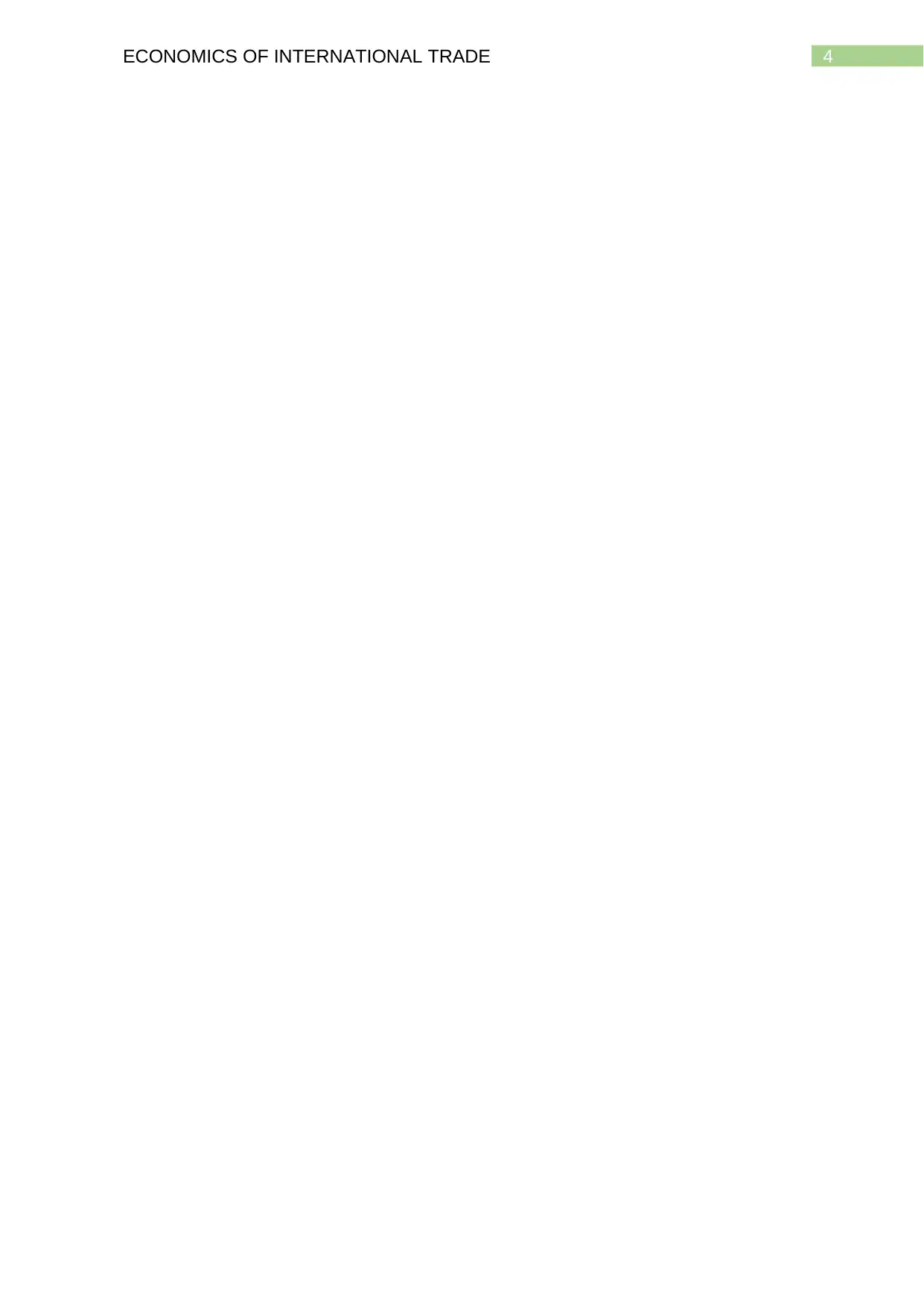
4ECONOMICS OF INTERNATIONAL TRADE
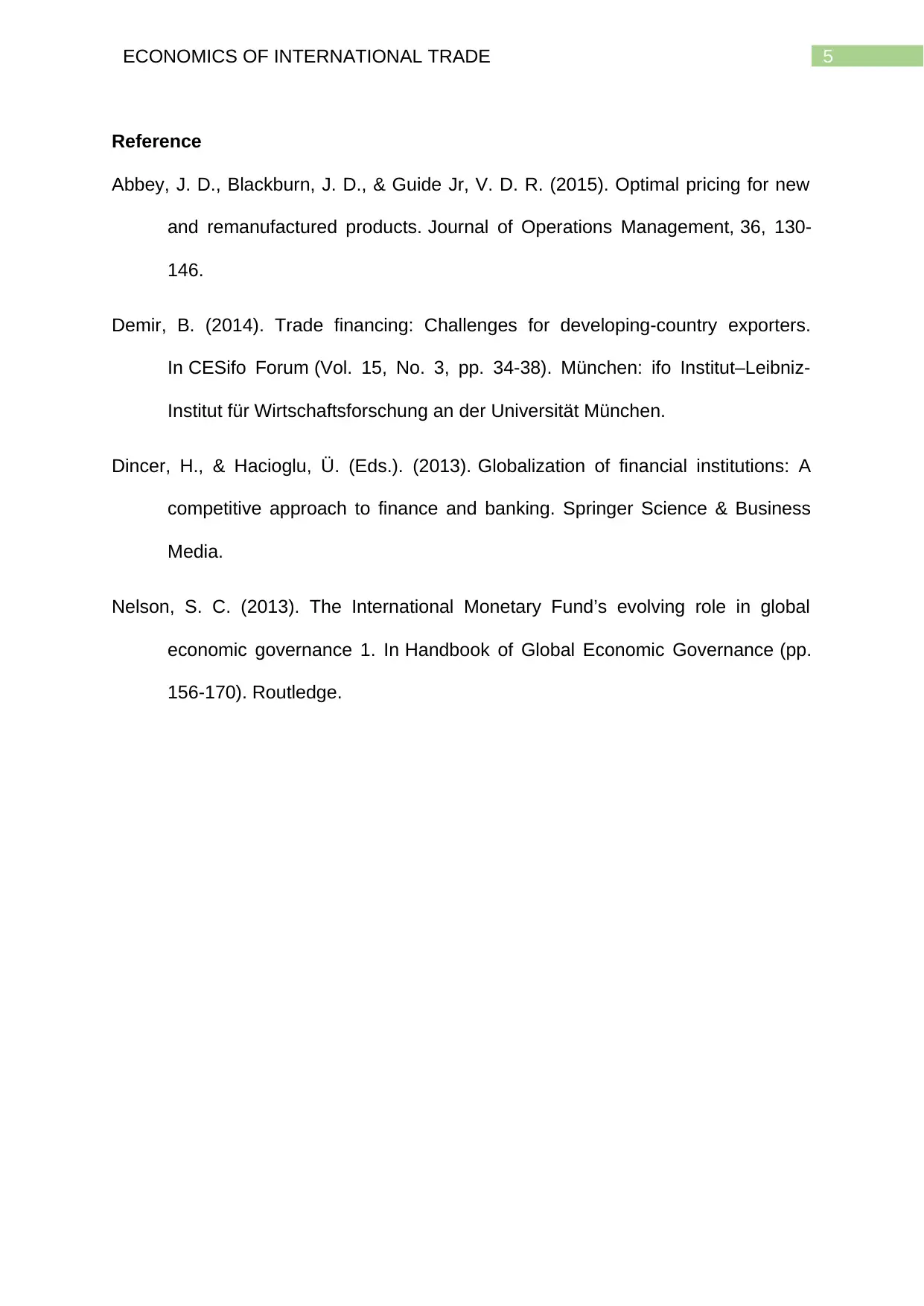
5ECONOMICS OF INTERNATIONAL TRADE
Reference
Abbey, J. D., Blackburn, J. D., & Guide Jr, V. D. R. (2015). Optimal pricing for new
and remanufactured products. Journal of Operations Management, 36, 130-
146.
Demir, B. (2014). Trade financing: Challenges for developing-country exporters.
In CESifo Forum (Vol. 15, No. 3, pp. 34-38). München: ifo Institut–Leibniz-
Institut für Wirtschaftsforschung an der Universität München.
Dincer, H., & Hacioglu, Ü. (Eds.). (2013). Globalization of financial institutions: A
competitive approach to finance and banking. Springer Science & Business
Media.
Nelson, S. C. (2013). The International Monetary Fund’s evolving role in global
economic governance 1. In Handbook of Global Economic Governance (pp.
156-170). Routledge.
Reference
Abbey, J. D., Blackburn, J. D., & Guide Jr, V. D. R. (2015). Optimal pricing for new
and remanufactured products. Journal of Operations Management, 36, 130-
146.
Demir, B. (2014). Trade financing: Challenges for developing-country exporters.
In CESifo Forum (Vol. 15, No. 3, pp. 34-38). München: ifo Institut–Leibniz-
Institut für Wirtschaftsforschung an der Universität München.
Dincer, H., & Hacioglu, Ü. (Eds.). (2013). Globalization of financial institutions: A
competitive approach to finance and banking. Springer Science & Business
Media.
Nelson, S. C. (2013). The International Monetary Fund’s evolving role in global
economic governance 1. In Handbook of Global Economic Governance (pp.
156-170). Routledge.
⊘ This is a preview!⊘
Do you want full access?
Subscribe today to unlock all pages.

Trusted by 1+ million students worldwide
1 out of 6
Related Documents
Your All-in-One AI-Powered Toolkit for Academic Success.
+13062052269
info@desklib.com
Available 24*7 on WhatsApp / Email
![[object Object]](/_next/static/media/star-bottom.7253800d.svg)
Unlock your academic potential
Copyright © 2020–2025 A2Z Services. All Rights Reserved. Developed and managed by ZUCOL.





